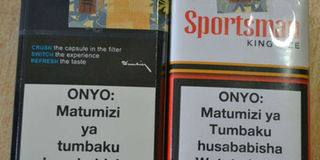Expect more deaths as tobacco firms seek new markets

This photo taken on May 29, 2015 shows messages on cigarette boxes warning users of the dangers of tobacco. Most of the initiation to smoking starts in school followed by the home. PHOTO | JEFF ANGOTE | NATION MEDIA GROUP
What you need to know:
- Roughly three million adults in Kenya currently use tobacco products with a majority being men.
- One of the reasons given for the increase in deaths is the affordability of tobacco products.
Each year, smoking and use of tobacco kills nearly 31,000 Kenyans aged 30 and above and about seven million people globally.
This, according to the World Health Organization, makes tobacco use one of the biggest public health threats the world has ever faced.
According to the Global Adults Tobacco Survey (Gats) 2014, approximately three million (11 per cent of the population) adults in Kenya currently use tobacco products with a majority being men (19 per cent).
At the same time, women account for five per cent of smokers.
PREVENTABLE DEATH
The Global Youth Tobacco Survey of 2013 showed that 10 per cent of Kenyan youth aged 13 to 15 are regular consumers of tobacco products like shisha and cigars.
Most (45 per cent) of the initiation to smoking starts in school followed by the home at 30 per cent.
In a report released ahead of World No Tobacco Day this past Wednesday, the UN agency warned that the annual death toll of seven million people had jumped from four million at the turn of the century, making tobacco the world’s single biggest cause of preventable death.
NEW TOBACCO MARKETS
And the death toll is expected to keep rising, with WHO bracing for more than one billion deaths this century.
“By 2030, more than 80 per cent of the deaths will occur in developing countries, which have been increasingly targeted by tobacco companies seeking new markets to circumvent tightening regulations in developed nations,” it noted.
One of the reasons given for the increase in deaths is the affordability of tobacco products.
For instance, while a cigarette pack, containing 20 sticks, costs between Sh120 and Sh250, shopkeepers and street vendors across the country sell a single stick for between Sh7 and Sh10, making these tobacco products accessible and affordable, a new survey by the International Institute for Legislative Affairs last year has shown.
HEALTH CARE
The total market value of cigarettes in Kenya is estimated at Sh35 billion, translating to about 7.4 billion sticks.
The situation is likely to worsen after a move by Treasury Cabinet Secretary Henry Rotich to introduce a two-tier tax structure, which would see plain cigarettes more accessible to those who smoke.
In the 2017/18 budget statement, the CS introduced a two-tier tax structure of Sh2,500 per 1,000 cigarettes with filters and Sh1,800 per 1,000 cigarettes for plain cigarettes.
Tobacco use also brings an economic cost: WHO estimates that it drains more than $1.4 trillion from households and governments each year in health care expenditures and lost productivity.





